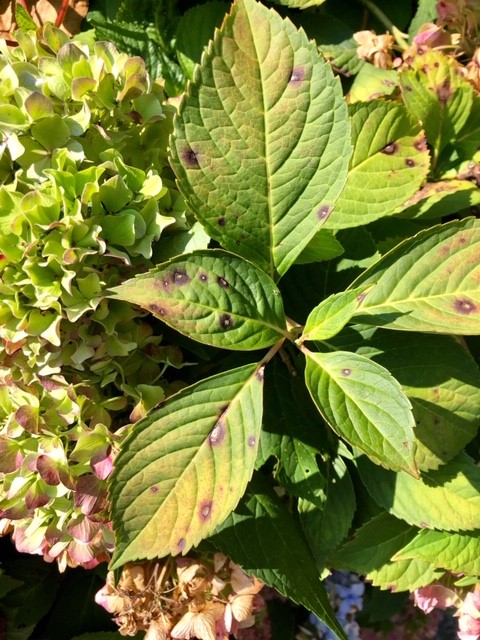The 5-Second Trick For Hydrangea Leaves Turning Yellow
The 5-Second Trick For Hydrangea Leaves Turning Yellow
Blog Article
Hydrangea Leaves Turning Yellow Fundamentals Explained
Table of ContentsAbout Hydrangea Leaves Turning Yellow3 Simple Techniques For Hydrangea Leaves Turning YellowUnknown Facts About Hydrangea Leaves Turning YellowThe Ultimate Guide To Hydrangea Leaves Turning YellowHydrangea Leaves Turning Yellow Can Be Fun For Everyone10 Simple Techniques For Hydrangea Leaves Turning Yellow
One opportunity is that the plant is not getting adequate sunshine. Throughout the winter season, the days are shorter, and the sun is not as extreme, so make certain to put your Hydrangea in a place where it will access least 6 hours of sunshine every day. One more reason for Hydrangea yellow fallen leaves in winter months can be too much water.The leaves could be turning yellow due to temperature anxiety. Hydrangeas like cooler temperature levels, so if the plant is in a spot that obtains as well warm or also cool, the leaves will transform yellow. If you believe temperature anxiety may be the concern, attempt moving your Hydrangea to a various location or protecting it from the components with a burlap wrap.
New development will be observed in early spring, when you'll notice eco-friendly vegetation sprouting from stems that might have shown up dead. However, if your fallen leaves are turning brown in spring or summertime, there are likely other aspects at play. The exact factors depend upon the variety and their expanding conditions, but as a whole, brown hydrangea leaves suggest dehydration and wilting in the warm
The Only Guide for Hydrangea Leaves Turning Yellow

Wilting is caused by lack of moisture, implying there are a few good techniques to make use of to stop this from taking place. Give your hydrangeas a healthy glug of water every few days when the temperature levels are climbing up high, and deal with the dirt to better retain dampness. After sprinkling, a dab of mulch around the base of each plant need to assist with this by maintaining wetness in the dirt.
This interrupts fungis spores from settling. "The Botrytis fungus grows in great and wet problems, so avoid showering the entire plant when sprinkling and simply water at the roots," shares Roy Nicol, a Master Horticulturist. If you've missed out on the opportunity for avoidance and are managing an infection you need to remove all dead or severely infected fallen leaves from the plant and destroy them to stop more spread.
Some Known Facts About Hydrangea Leaves Turning Yellow.
As a basic policy of thumb, we recommend eliminating leaves when they are 50% brown or greater. While browning brought on by any type of reason can't be reversed, taking the rehabilitative action defined above will motivate the plant to grow new fallen leaves so the damaged leaves either fall off naturally or can be eliminated by the gardener.
Hydrangeas should be watered only when the top couple of inches of soil are dry, and should be offered a complete saturating each time. Underwatered hydrangeas are likely to have yellow, wilting, and drooping fallen leaves. Raise the frequency and quantity of sprinkling for your shrub to assist fix this problem. Hydrangeas prefer relatively damp (yet not soaked) dirt, so give the roots an excellent saturating and permit water to be soaked up into the soil prior to applying more.
The method you deal with hydrangea leaves turning yellow depends on the crucial problem triggering the yellow leaves. This can be hard to identify, but as soon as you do you will have the ability to adjust your plant treatment as necessary to take care of the problem. As discussed before, a common issue with hydrangeas is vitamins and mineral deficiencies.
The Buzz on Hydrangea Leaves Turning Yellow
Throughout the peak growing season, you must water at a rate of concerning 1 inch weekly. If you are worried concerning not appropriately sprinkling your hydrangeas, there are a number of points you can do. Adding compost to the base of the plants over the origin area assistance to control the temperature level around the bush and retain water in the dirt.
You can purchase and mount basic watering globes. Sprinkling globes hold water in them and slowly release this water into the soil as the ground becomes dry. Just load the globe with recommended you read water, stick the spout right into the dirt within the origin zone near the base of the plant, and leave it in position up until all the water is gone.
If it is also serious, some plants will never recoup from transplant shock and will remain to decline till they die. Minimize transplant shock by consisting of as numerous Read Full Report roots as possible when digging up your plant to relocate. Make sure to provide even more water than usual in the weeks following growing to assist your plant recuperate and grow new origins.
The Facts About Hydrangea Leaves Turning Yellow Uncovered
To prevent spreading fungal conditions, make sure to thouroughly tidy and decontaminate any type of trimming tools before and after usage. Lastly, you can try to flush the roots with water to eliminate excess fertlizer.
Your hydrangea plant prefers well-drained, wet dirt. If the pot has inadequate water drainage, or your soil is flooded, the fallen leaves will certainly begin to transform yellow. Overwatering makes the soil soaked (Hydrangea Leaves Turning Yellow). Swamped and soaked dirt can bring about stunted development, leaf discoloration, and, worst of all, rot fungal diseases. Despite the fact that over-watering can be dangerous, under-watering is not an option either.
If you do not sprinkle your hydrangea plant for more than a week, the go to the website fallen leaves will begin turning yellow. Fungal diseases that attack the plants tend to reveal indicators on the origins and the leaves of the plant. Among these diseases is root rot, that makes it difficult for the plant to feed effectively.
Unknown Facts About Hydrangea Leaves Turning Yellow

Report this page